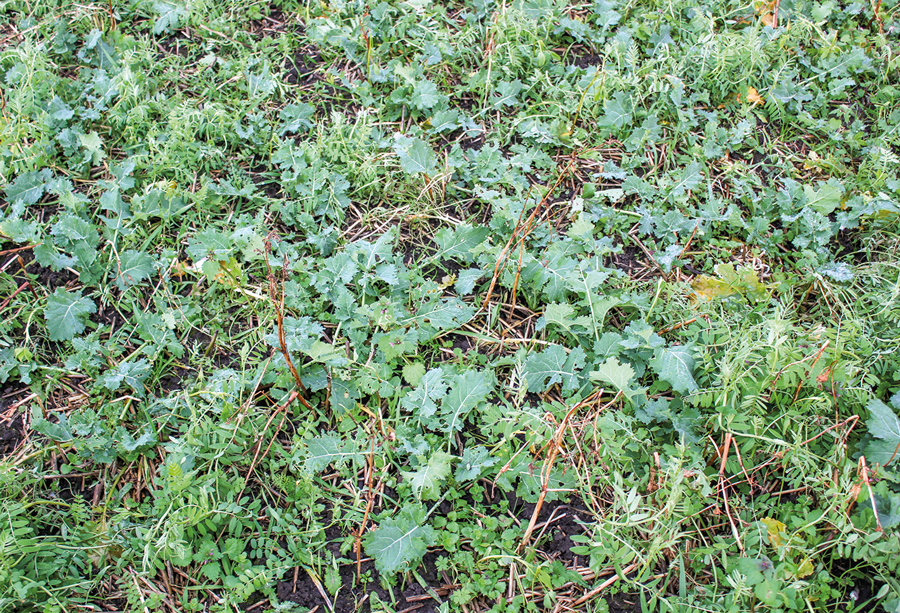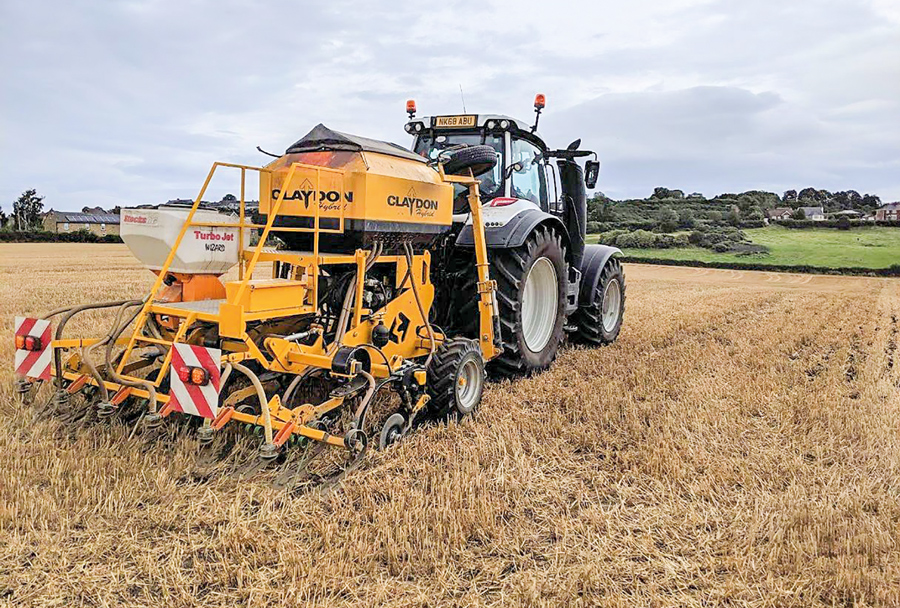Insecticide-free regime defies flea beetle in North East
10th March 2020
Flea beetle pressures have grown markedly at Dunkirk Farm, Birtley, overlooking Gateshead’s Angel of the North, in recent seasons. Yet David Hankey continues to grow crops of OSR that rival winter wheat in their margin-earning. And he does so without using any insecticides.
David Hankey puts his success with oilseed rape down to the direct drilling regime the business has developed over the past five years improving soil biology and resilience; a recipe that includes an extended rotation, regular additions of local authority compost and horse manure from neighbouring stables; cover and companion cropping; and vigorous, fast-developing OSR varieties. Having given up cattle in 2002 to concentrate on arable cropping with horse hay and haylage production on his 140ha family farm, Mr Hankey was finding the sandy loam soils becoming markedly more prone to slumping and surface water run-off. Things came to a head in the winter of 2012 when over 450mm of rain between August and December necessitated a serious amount of spring re-drilling.
“We could see things were going downhill without farmyard manure from stock and grass leys in the rotation,” he explains. “So, we decided to move from our traditional plough and combi-drill system to direct drilling to try to get back to the first-class soil conditions we always had under our grassland.
“At the same time as buying our Claydon drill, we moved from a five-year, all winter cropping regime to a six-year rotation involving first wheats after OSR and beans, and both winter and spring barley. We also introduced cover cropping, initially with a proprietary mix and then with our own purpose-built combination of tillage radish, oil radish, phacelia and buckwheat.
“As part of this approach we gave-up spraying insecticides to avoid killing beneficials too,” adds Mr Hankey.
“For the first few years we chopped all our cereal straw and left it on the surface for natural incorporation. But it’s too valuable around here. So now we bale it all for local sale and bring in green compost and horse manure instead.”
Compost
Around 25t/ha of compost is applied to around half the arable acreage each year. This season’s rape ground received it on the preceding crop of Sunningdale winter barley in late February, where it was rapidly incorporated by the ground’s thriving worm population – no less than 33 in a spadeful at the most recent count.
Having baled and removed the straw from the impressive 11.4t/ha crop, Mr Hankey put in a mix of vetch and buckwheat with his Claydon on 23 August, drilling his OSR at an angle to the companion crop the following day, with berseem clover spread from a Stocks seeder on the back of the drill. A deliberately slow 4mph pass with a heavy set of rolls completed the process, enabling him to get the four separate species sown under the best conditions for each despite only having a single hopper machine.
“On the advice of our Agrii seed specialist, we moved from old favourite, DK Extrovert, to newly-Recommended DK Exsteel this season, drilling it in at 32 seeds/m²,” says Mr Hankey. “Reliable establishment and fast autumn development is something we can’t do without in our varieties. But it’s important we don’t end up with overly-dense canopies.
“As well as a consistent top performer in their trials, Agrii research shows the variety is one of the most vigorous autumn and spring developers available – characters associated with much lower levels of damage from both adult beetles and larvae in their work.
“Supported by a little DAP in mid-September, the Exsteel took off every bit as well as we were promised with almost 100 per cent establishment. And it needed to, with flea beetle causing a number of local crops to be pulled up and our no-insecticide policy.
“The mustard we had as part of our cover crop mixture in the next-door field got badly hammered. And in the small area of the 10ha field where we ran out of companion seed, there was much more shot-holing. But the combination of very rapid OSR and companion crop growth meant the bulk of the ground was well-covered in short order and suffered remarkably little beetle damage.
“The buckwheat, which died off after the first frosts, did a particularly good early job here,” he points out.
“It’s also known to be valuable in making phosphate more available and its flowers apparently attract a species of wasp that parasitises flea beetle.
“The main flea beetle management value of our companion cropping, though, seems to be in making the field look unlike OSR. We’ve certainly found pigeons either don’t recognise the crop with a companion or are put-off landing in it, too.
“The vetch took over as the dominant companion after we lost the buckwheat and we maintained its pigeon deterrent value – as well as maximising its nitrogen-fixing contribution – for as long as we could by holding off on our AstroKerb until well into January.”
Soil structure
The flea beetle-defying establishment and early development of Dunkirk Farm’s OSR almost certainly also owes much to the very visible soil structural and health results of David Hankey’s determined improvement efforts.
Despite an early winter paralleling 2012 for its relentless wetness, ground badly affected by surface erosion and waterlogging little more than five years ago showed none of its former vulnerabilities. Indeed, it survived the challenge remarkably well, maintaining a great combination of firmness and friability, a level surface pock-marked with worm casts and a wonderfully humus-rich smell.
“Our direct drilling regime is working a treat,” reflects Mr Hankey. “Our soils hold much more moisture when conditions are dry and in the wet their carrying capacity is so much greater than it used to be. In many cases our headlands are now performing as well, if not better, than the rest of the field. We can drill much later into the autumn and get onto our land earlier than anyone else in the spring.
“It’s all about building-up the soil biology rather than disrupting it every year with the plough, like we used to. The Claydon does a fantastic job in moving the bare minimum of soil at drilling. Adding a spring crop into the rotation has taken the pressure off winter fieldwork. Cover cropping ahead of both winter and spring crops has been a real revelation in breathing extra life into the soil. We’ve measured oil radish roots down to 19in in places, and have found both beans and peas useful alongside more normal cover species.
“It’s been a steep learning curve and we still have a lot to understand about the science of soil improvement, though,” he insists. “That’s why we’re trialling different winter cover mixes alongside our own mixtures across the farm this season.
“We’ve also deliberately left one field unplanted to try a summer cover ahead of next year’s OSR. Together with a companion crop, we’re looking to see how well we can maintain an active population of mycorrhizal fungi to benefit our following wheat crop.”

Taken in December, the picture shows that DK Exsteel within the companion crop survived flea beetle attack well.

